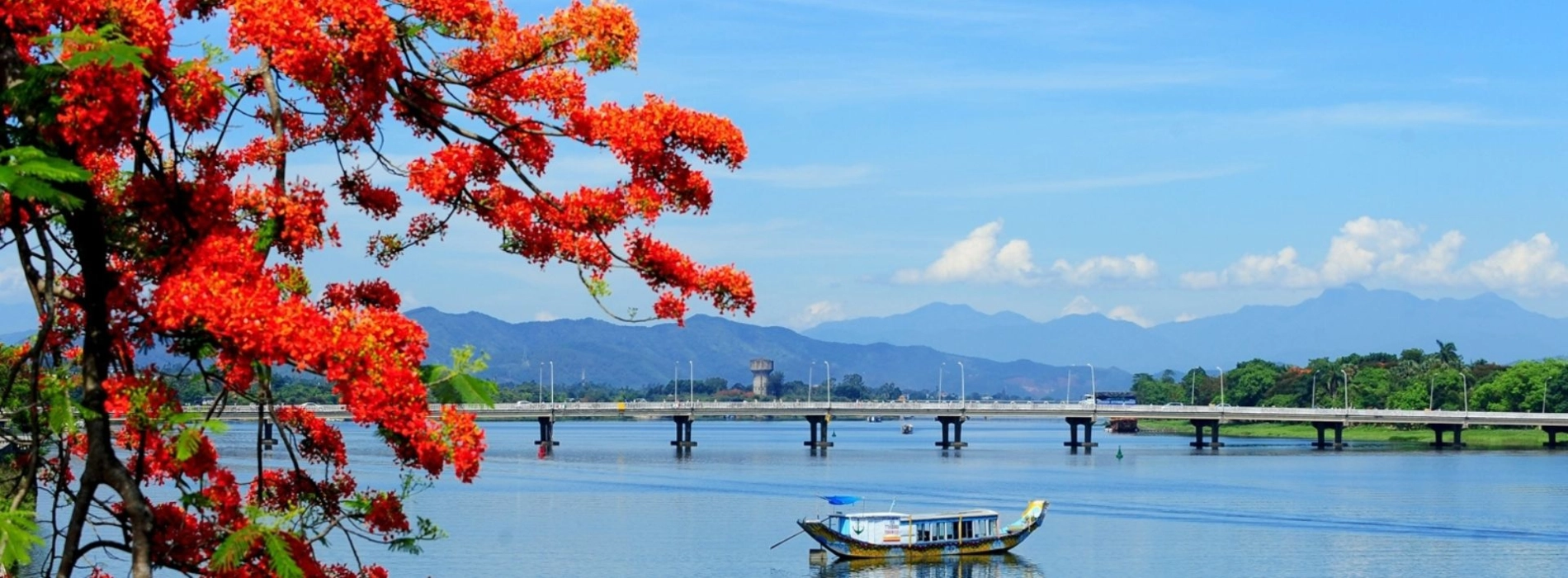Huong River

The Huong or Perfume River is one of the most symbolized landmarks in central Vietnam. Flowing through Hue, the old imperial capital, the river flows approximately 80 kilometers from the Truong Son Mountain Range to the Tam Giang Lagoon. It derives its poetic moniker from scented blossoms which shed over its waters in the orchard's upriver side, particularly in autumn, which is carried in it giving it the lovely smell forming part of its romance profile.

The beauty of Huong River (Source: Pixabay)
The Huong River originates from the "Dai" and "Ta Trach" streams of the Truong Son Mountain Range. Both the sources converge at Bang Lang Fork and flow approximately 80 kilometers before it empties into the Tam Giang Lagoon. The river passes through Hue itself, which makes the city strategically and naturally important.
What makes the Huong River unique is not just its name, which came from the scented flowers that once fell into its waters, but also its color and peaceful flow. Unlike most rivers that rage or swell, the Huong moves slowly and peacefully, so that its surface can reflect the sky and landscape surrounding it like a mirror. When the days are clear, the pagodas, pine dotted hills, and traditional Vietnamese houses are reflected in its deep, clear water.

Origin of the Huong River (Source: scootersaigontour)
The ideal time to go to the Huong Bridge is between January and April, when Hue's weather is pleasant, cool, and dry. It avoids the monsoon rains' intensity and the summer months' blistering heat. In springtime, the river lives up to its name, with blossoms flowering across the landscape, adding to the scenic boat trips and riverside strolls. If you're interested in culture, visit during the biennial Hue Festival in April, when traditional music, art, and performance often take place along the riverbanks.

Best time to visit (Source: TravelBus)
One of Hue's most hallowed experiences is a dragon boat journey down the Huong River to Thien Mu Pagoda. The traditional boats, sometimes exquisitely decorated, travel slowly downstream, offering travelers a serene vehicle for soaking up serene surroundings. The journey is as delightful as the destination, with views of fishing boat spattered riverbanks, rural houses, and green gardens.
Thien Mu Pagoda itself is a stunning seven story pagoda which has survived since the 17th century. Travelers may stroll around the grounds of the pagoda, which include a 1710 cast giant bell, stone turtles with steel carrying backs, and neatly manicured gardens promoting tranquility and reflection.

Dragon boat on Huong River (Source: Expedia)
The Imperial City of Hue, a sprawling citadel surrounded by thick stone walls and defense moats, rests along the Huong River. Individuals may walk across the Truong Tien Bridge to arrive here. Inside its walls, you will find the Forbidden Purple City, once reserved exclusively for the emperor and his family, and numerous palaces, shrines, and halls.
The river atmosphere goes well with the ancient architecture and makes you wonder if time has stopped. During the celebration of national holidays or festivals, you can see reenactments or traditional dances that spring to life and bring alive the rich history of the city. Audio guides or guided tours add a richer experience by bringing alive fascinating facts concerning court ceremonial and architectural symbolism.

Imperial City (Source: GadtTravel)
A stroll or bike ride along the sunset hued Huong River is a favorite of locals and foreigners alike. The riverside promenade has shaded walkways, street food stalls, paintings, and occasional cultural performances. It is the perfect time to watch life in Hue unfold, from kids flying kites to street vendors selling such daily treats as grilled corn or sweet soup.
Cycling offers the choice of cycling further, perhaps to neighboring villages or to Thuy Bieu with its old garden houses and pomelo orchards. At sunset, the river is a sheet of rose and gold, a peaceful, poetic end to the day.

Cycling by the Huong River (Source: CyclingVietnam)
Hue is readily accessed by various forms of transport. Phu Bai International Airport, which is 15 kilometers away from the center of the city, has flights every day from Hanoi, Ho Chi Minh, and Da Nang. Anyone visiting Hue will be able to get access to a shuttle bus or taxi from the airport to the riverside.
For those coming by train, Hue Rail Station is readily accessible and connected to the Reunification Express track running between north and south Vietnam. Bus and private transport from major cities like Da Nang (about 100 kilometers away) also offer a scenic route via Hai Van Pass.

Hue Rail Station (Source: Klook)
Upon arrival in Hue, the Huong River cannot be escaped. It courses through the center of the city, and many hotels, restaurants, and attractions are within walking distance along the riverbanks. Local transportation such as cyclos, motorbikes, and taxis are also available for short trips to riverside locations.
The Huong River is not merely a river, it is the soul of Hue, as it has its history, culture, and nature. Whether boat rides past ancient tombs, sitting at a riverbank pagoda for meditation, or just a cup of coffee while the river glides by, each activity in the vicinity of the Huong River provides you with an experience of Vietnam's soul. In order to maximize your holiday, count on Asia King Travel to arrange your vacation. Our local insight, custom tailored itineraries, and caring service ensure that you will not miss a moment.
Read more: Hue Tour 3 days: Journey into Vietnam's Historic Heartland